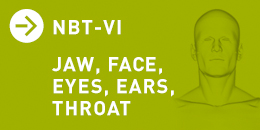NBT VI focuses on the treatment of the head, jaw, tongue, throat, palate and eye muscles. Other aspects for the course deal with the movement and tracking analysis of the jaw and jaw joint.
Analysis of range of motion of the jaw provides the necessary information about tension patterns of the associated masticatory and facial muscles. From the analysis the therapist will be able to create a detailed treatment plan for their patients.
The relationship between the position and function of the temporomandibular joint and pelvis are discussed to illustrate the involvement of structural imbalances in facial, jaw and neck pain.
Conditions such as decreased range of motion of the TMJ, various headache patterns, vision disorders, swallowing difficulties, speech impediments, chronic neck pain, chronic inflammation of the nose and throat areas, snoring, sleep apnea, chronic cough as well as facial and temporomandibular pain are discussed and treatment techniques for the associated musculature is taught. This leaves each participant able to create individualized treatment plans for patients that present with these conditions.
Many of the techniques are very new to most participants. Models of the skull are available and will be used by the instructors to show the location of the muscles treated. Also proper hand and finger placement are shown on the models. Participants are encouraged to use the models before applying the techniques on their course partner.
Treatment techniques for the following musculature are taught during the course:
- Muscles and fascia of the skull
- Facial muscles
- Masticatory muscles
- Palate and throat musculature
- Hyoid muscles
- Eye muscles
- Ear muscles
- In addition movement techniques for the mobilization of the temporomandibular joint, exercises for the muscles of the eyes and many self-treatment techniques are covered in the course.

